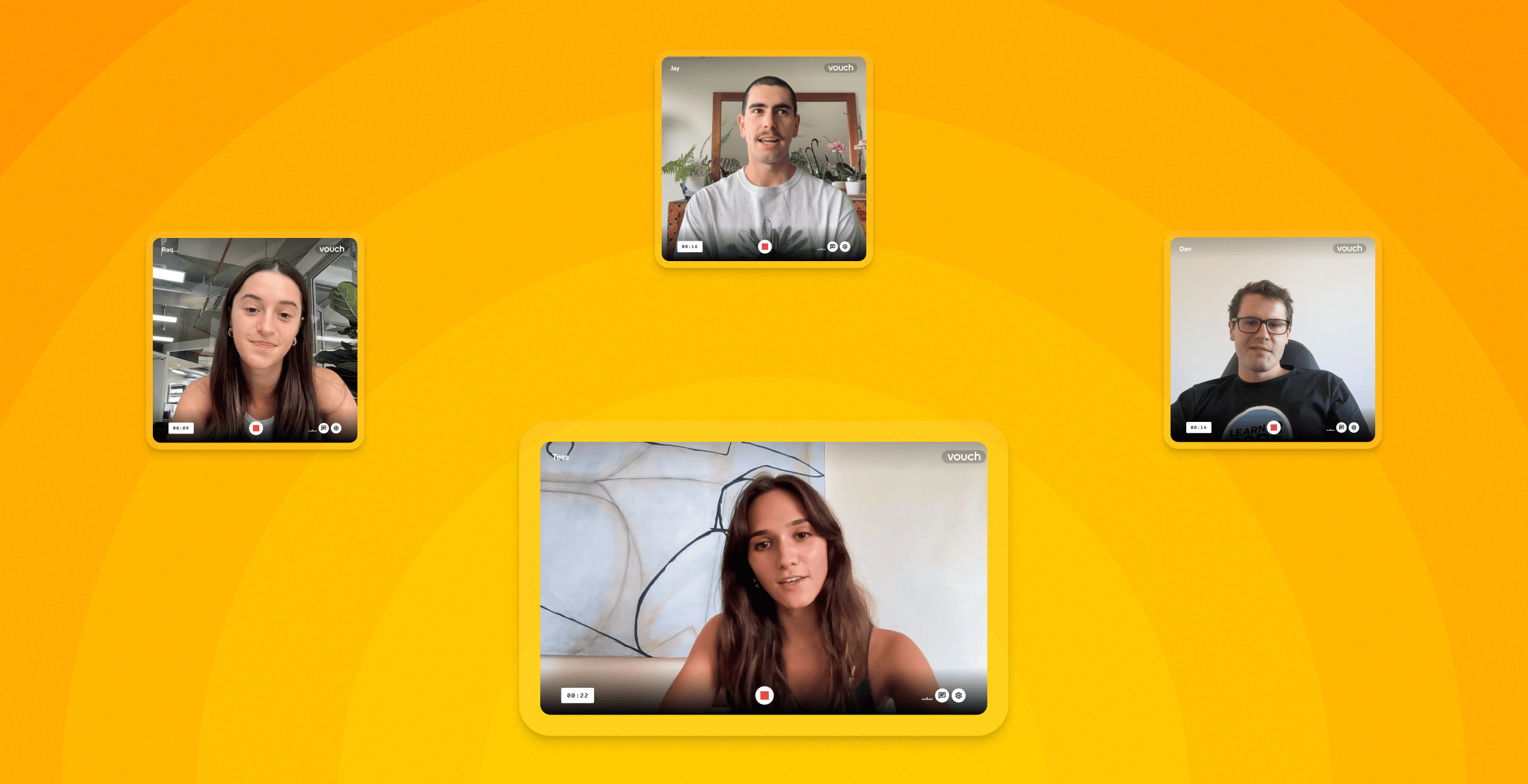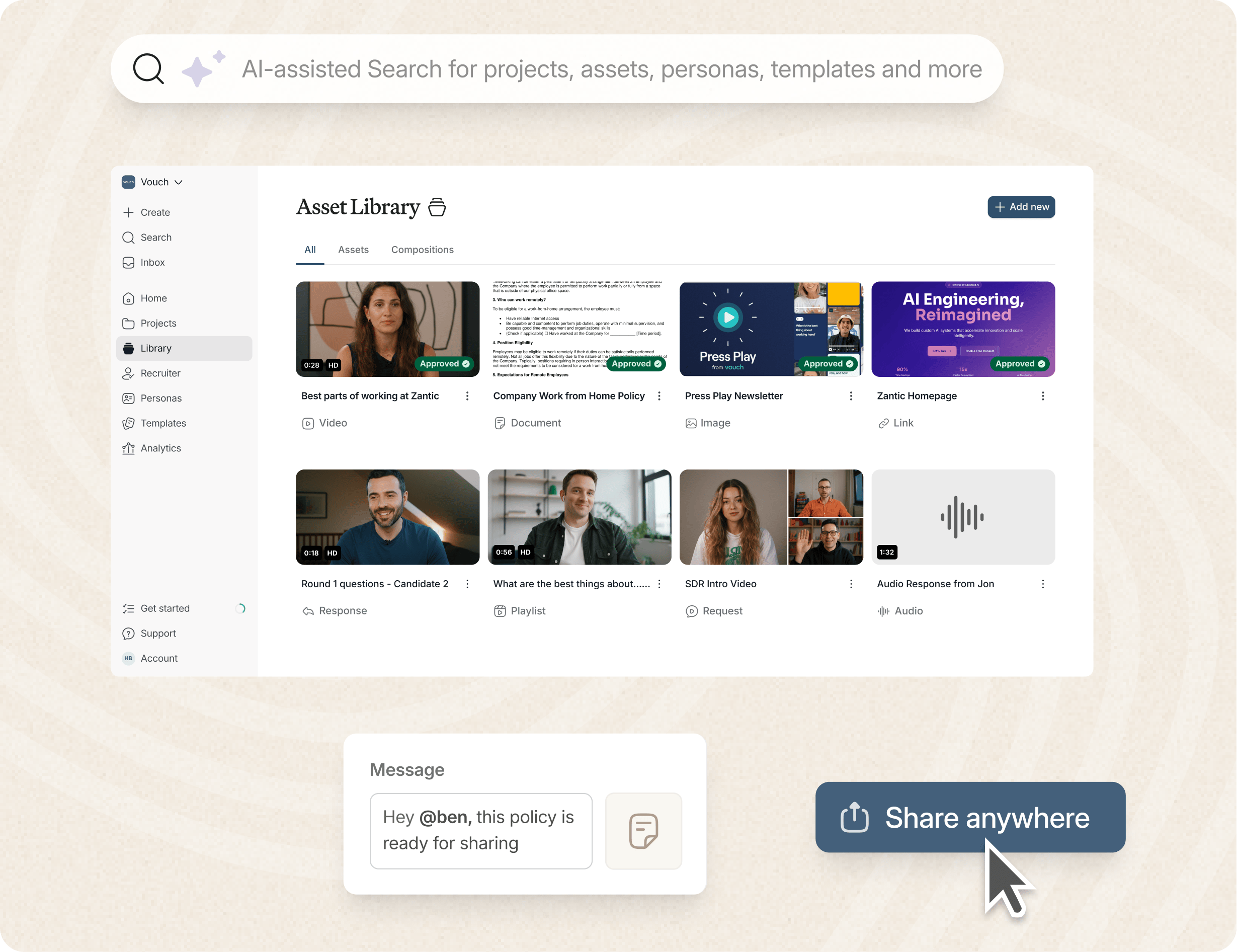
7 Proven Strategies: Effective Team Communication in 2026
Your team's communications are like glue, and having effective team communication strategies is key to keeping everyone together, avoiding misunderstandings, and driving an amazing company culture.
The statistics on company communications are staggering, including this stat from Motivational Speakers: 65% of employees want more communication with their managers.
Employees themselves are crying out for better internal communication.
Let's get started.
Key Takeaways
- Trust and respect are the core of all effective team communication strategies.
- Teaching your team "active listening" can make a world of difference.
- Making sure that each person knows exactly what they're supposed to do is vital.
- Using modern communication tools like Vouch can really help, especially in larger teams.
Effective Team Communication: The 7 Best Strategies In 2026
In 2026, we live in a complex multi-channel world.
Combine that with larger companies, and we're often rarely standing in the same room together when we communicate, too.
This means that your employees (100 or 10,000) can feel disconnected, and when this happens, people can feel like just another cog in the wheel.
We need to fix that because, according to Gallup, $8.9 trillion was lost in global GDP due to low engagement. That's how big the problem is.
With that in mind, let's look at the strategies top companies are using for effective team communication.
1) Establish A Culture Of Authenticity
The first step to effective team communication is making sure everyone feels comfortable sharing their thoughts, ideas, worries, and feedback in a straightforward and nurturing way - regardless of their personal communication style.
For this kind of environment and team collaboration to work, your leaders must show how it's done—which is often the biggest hurdle.
One brilliant way to start building a more open culture is to have your executive team share a company update via video every week or fortnight.
While a one-way update, you would be amazed at how these simple video updates can transform your entire company culture.
In fact, this is exactly what some of our clients, such as Nike, Canva, Cisco, HubSpot, and others, do.
To learn more, simply head here: Team Updates That Work.
2) Build A Culture Of Trust and Respect
With authenticity comes trust and respect, which are a must for effective team communication.
When everyone on the team trusts and respects one another, they're more open to talking freely, sharing their thoughts, and working together towards shared goals.
One way to start building a culture of respect is to actually let your employees tell their stories and experiences without fear of judgment or criticism.
We've created a guide on "employee spotlight videos" here, and they work remarkably well: 25 Brilliant Spotlight Questions for Employees.
The AI-enabled workspace for talent teams.
- Unified workspace for talent teams
- Accelerate hiring with AI tools
- Auto-generate polished hiring and employer brand content
- Easily repurpose assets across all channel

3) Encourage Regular, Open Employee Feedback
Building on your authenticity and trust, having open and regular chats with your team is a must.
Tools like Slack make it easy to have a quick Huddle or stand-up, and regular Zoom or Google Meets can also provide an amazing platform for regular catch-ups.
The key is to create a short and punchy "check-in" meeting so that your team can take their challenges offline and work closer together to solve your business problems.
Team morale and motivation are often also vastly improved; it's a massive win-win.
For these kinds of huddles to happen, though, your team managers need to initiate and regulate them. Again, the key is consistency while keeping the meetings short.
4) Promote (And Teach) Active Listening To All Employees
Teaching active listening is vital for effective team communication.
Active listening means paying close attention to, understanding, and responding thoughtfully to every employee in your team and the company as a whole.
Active listening also emphasizes empathy and enhances teamwork by improving mutual understanding.
We're currently creating a guide on active listening, taking the learnings and "best of" tips from teachers like Very Well Mind, Mind Tools, and more, so stay tuned for that!
5) Ensure Clarity Across All Roles and Responsibilities
Making sure everyone knows what their roles and responsibilities are is vital for effective team communication.
Leaders also need to understand everyone's roles and clearly communicate what they expect from their employees, with clear KPIs and underlying facts like the culture they want to create.
By clearly defining roles and responsibilities, teams and employees can avoid misunderstandings and develop more effective communication strategies overall.
Employee engagement models are the foundation of this, and we've a great guide here if you are looking for more information: 5 Proven Employee Engagement Models.
6) Leverage Modern Digital Communication Tools Like Vouch
Using modern ways to talk and work together online is vital for effective team communication.
With tools like Vouch, your team can create a simple, short video that explains their thoughts while avoiding misinterpretation. This happens frequently in emails without tone or visuals.
One-way video is used by some of the world's best companies (like these companies) because it works on so many levels.
There is a hidden benefit: Videos are personal. Emails, Slack messages, etc., are great for one-way communication, but they miss a vital component—seeing a real person.
7) Sincerely Reward Your Team's Efforts and Achievements
Empathy is at the heart of employee experience, and showing your sincere appreciation for your team's efforts and dedication is vital.
When you show gratitude for each member's effort and input, it lifts their spirits, motivates them, and encourages them to do their very best work—and you can't ask for more than that!
Rewarding your employees does not need to be monetary either; in fact, according to Reward Gateway, nearly 60% of employees would prefer regular praise and thanks over a 10% pay increase with no recognition.
Think about that for a second. Even in 2026, when most people are under more financial stress than they have been in the last 30 years, most people would still choose recognition over money.
All of this ties directly back to your company culture, and we've put together a trendy guide to workplace culture that we think you'll love.
What Other Strategies Do You Need To Consider?
When it comes to effective team communication, there are also a few underlying factors that HR teams and leaders need to work on.
These are usually more "behind the scenes" strategies, so let's dive in:
Develop Simple Conflict Resolution Strategies that Everyone Understands
Creating easy-to-understand ways to solve disagreements is critical to effective team communication.
In every company, 100 or 100,000 employees, when people work together, there are always conflicts.
Having a straightforward process for dealing with conflict is vital, and we love this guide from Mind Tools.
Focus On Your Diversity And Inclusion
Diversity and inclusion are such large topics that we suggest reading this guide if you need to improve in this area in your business.
You can find the guide here: DEIB meaning: Diversity, Equity, Inclusion, and Belonging.
In almost every industry today, the companies that understand DEIB, know what it means to not only their workplace culture but also their revenue and growth.
Studies have shown that diverse companies outperform industry norms by 35%, that's how powerful DEIB is.
Support Continuous Improvement and Learning
Have you ever read about the Google 20% rule?
Early in the company, Google executives created a 20% rule to give employees the ability to spend 20% of their time on innovation projects that were not directly connected to their role or KPIs. It's a wild concept for many companies, but one you really should be paying attention to, as this strategy can go a long way in supporting continuous improvement and learning through strong communication.
This means creating an environment where employees feel comfortable sharing their ideas and thoughts, sparking innovation, and driving the entire company forward through regular check-ins, such as weekly meetings, and other methods of encouraging feedback from all team members to improve team productivity.
3M, for example, has had a 15% rule for decades that allows its engineers and scientists to spend up to 15% of their time on their own projects.
Here at Vouch, we have our internal version of this rule, and it's key to keeping our team at the forefront of video technology and, of course, inspired to keep making Vouch the very best tool in its class.
The examples go on and on, but if this is beyond your company's capability, consider the LMS systems available today (like these) that provide amazing courses from industry experts and authorities.
LMS platforms are perfect for busy teams, too; just be sure to allocate time for your employees to improve themselves.
What Is The Financial Impact of Effective Team Communication?
Some of the statistics regarding effective team communication and employee experience in general are quite eye-opening.
Probably the biggest stats are from Gallup, with data that indicates that disengaged employees cost the U.S. economy alone $450 - $550 billion per year, and globally, this is estimated at up to $7.8 trillion.
The financial impact of poor team communications, even in small companies, should never be underestimated.
When teams work effectively together, decisions are made faster and smarter, and your company culture is vastly improved. This means you attract more top talent, and your growth snowballs.
Of course, team communications are part of your wider company culture.
If this is an area you need to work on, we suggest reading this guide: Managing A Workplace Culture Change, The 6 Big Steps.
What Software Can Help You Improve Your Team's Communication?
Choosing the right communication tools for your team is the very first step.
You need to create seamless information exchanges, especially across teams with different backgrounds and disciplines, from your sales team to your tech, logistics, and engineering teams.
In many larger companies, there is an internal communications specialist who helps organise tools, processes, backup data, and policies (all extremely important).
That said, here are a few popular tools we love, including those that even help you see your team's body language over Video and those used by companies of all shapes and sizes.
Note: We've left out phone calls and emails, as these are a given.
1) Messaging Platforms
- Slack: Allows for real-time messaging, file sharing, and integration with other tools.
- Microsoft Teams: Integrates with Microsoft Office 365 and offers chat, video conferencing, and file storage.
- Vouch: The perfect tool for creating and sharing videos with your team, from training to keeping everyone on the same page.
2) Project Management Tools
- Trello: Uses boards, lists, and cards to help teams organize and prioritize projects.
- Asana: Enables teams to track project progress, assign tasks, and set deadlines.
- Jira: Ideal for software development teams, offering issue tracking and agile project management features.
3) Document Collaboration Software
- Google Workspace: Provides a suite of productivity tools like Gmail, Google Docs, Sheets, and Slides, allowing for real-time collaboration.
- Dropbox Paper: A collaborative document-editing tool that integrates with Dropbox file storage.
4) Video Conferencing Tools
- Zoom: Offers reliable video conferencing with features like screen sharing and breakout rooms.
- Microsoft Teams: In addition to chat, it provides robust video conferencing capabilities.
- Google Meet: Integrated with Google Workspace, it allows for easy scheduling and joining of meetings.
5) Document Sharing and Management
- Google Drive: Allows teams to store, share, and collaboratively edit documents in real-time.
- Dropbox: Provides file storage and sharing capabilities with collaborative features.
- OneDrive: Part of Microsoft Office 365, offering seamless integration with other Microsoft tools.
6) Internal Social Networks
- Yammer: A social networking service for enterprise communication integrated with Microsoft Office 365.
- Workplace by Facebook: Uses familiar Facebook features tailored for workplace communication.
7) Digital Whiteboards
- Miro: An online collaborative whiteboard platform ideal for brainstorming and planning sessions.
- Microsoft Whiteboard: A freeform digital canvas where people, content, and ideas come together.
By leveraging these modern tools and technologies, you can often go beyond verbal communication alone, and your teams can enhance communication, streamline workflows, and foster a more collaborative and efficient work environment.
FAQs
Why is effective team communication crucial for a company?
Effective team communication is essential because it prevents misunderstandings, fosters a positive company culture, and ensures that everyone is aligned with the company's goals and objectives.
What role does authenticity play in team communication?
Authenticity is crucial as it encourages team members to share their thoughts, ideas, and feedback openly, which is foundational for building trust and respect within the team.
How can active listening improve team communication?
Active listening improves team communication by ensuring that team members fully understand each other's perspectives, which enhances mutual understanding and empathy.
Why is it important to clarify roles and responsibilities in a team?
Clarity in roles and responsibilities helps avoid misunderstandings, ensures that everyone knows their tasks, and allows the team to work more efficiently towards common goals.
How can modern communication tools like Vouch benefit a team?
Modern communication tools like Vouch facilitate clear and concise communication through video messages, reducing misinterpretations and adding a personal touch to interactions.
What are some ways to encourage regular and open employee feedback?
Regular check-ins, using tools like Slack for quick huddles, and scheduling consistent meetings on platforms like Zoom or Google Meet are effective ways to encourage open employee feedback.
How can rewarding team efforts improve communication and morale?
Sincerely recognizing and rewarding team efforts boosts morale, motivates employees, and reinforces a culture of appreciation, leading to better overall team communication and performance.
Conclusion
Effective team communication strategies are vital for every company, from start-ups to global giants.
It can't be understated how important communications are for your workplace culture and employer brand, too. These are key to increasing retention and attracting top talent in the future.
Establishing a company culture of trust, respect, and open dialogue ensures that every team member feels valued. Good team communication absolutely relies on these communication pillars. Encouraging active listening skills, clarifying roles, and leveraging modern tools like Vouch for information sharing are also vital for team building.
Use Vouch For Effective Team Communications!
Loved by companies like Canva, Nike, Cisco, HubSpot, Amazon, and more, tools like Vouch make leveraging video in your business remarkably easy.
Be sure to book a Vouch demo today to chat with a video content expert.
You might also like

Elevate Your Brand Today With Vouch
Discover how Vouch can accelerate talent acquisition while helping you stay on-brand.





